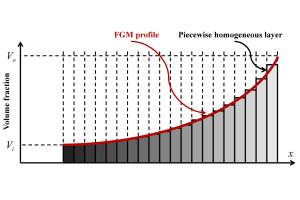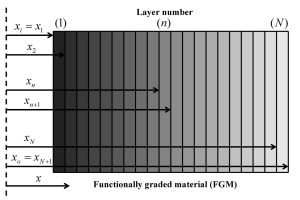 Piecewise Homogenous Approximation of FGM Profile |
Description
Compared to homogenous materials, gradual changes in material properties can be tailored to reduce in-plane and out-of-plane stresses, delamination, residual stresses, crack initiation as well as to augment fracture toughness. Controlled spatial transitions in either the composition and/or structure of a material can result in improved thermal, fatigue and corrosive resistance, as well as desired system responses, such as electric, magnetic, thermal, hygroscopic and other physical attributes. They can also be used to target antagonist requirements imposed by a given application as well as to find optimized distribution of material properties that match those existing at the boundaries of a given domain (see, for example, the project Hip Replacement Implants in Research Track 2).
Structural gradients in solids and cellular media can be obtained via multiple routes including transition in volume fraction, change in material properties, and geometric tailoring of the parameters defining a cellular solid. Stereolithography, selective laser sintering, and fused deposition are among additive manufacturing processes currently used to build FGM. We have recently started investigating the multiphysics responses and interactions occurring at multiple length scales in functionally graded solid materials (FGM) and are extending the framework to functionally graded cellular solids.
Relevant Publications
- A. H. Akbarzadeh, D. Pasini, Multiphysics of Multilayered and Functionally Graded Cylinders Under Prescribed Hygrothermomagnetoelectroelastic Field, ASME Journal of Applied Mechanics, Vol. 81(4), 041018-1, 2014. link to PDF
- Khanoki Sajad A., Pasini, D., Multiscale Design and Multiobjective Optimization of Orthopaedic Hip Implants with Functionally Graded Cellular Material, Journal of Biomechanical Engineering, vol 134 (3), 2012. link to PDF
- Khanoki, S. A., Pasini, D., The Fatigue Design of a Bone Preserving Hip Implant with Functionally Graded Cellular Material, ASME Journal of Medical Devices, Vol. 7(2), 020908, 2013.
- Khanoki Sajad A., Pasini, D., Fatigue design of a mechanically biocompatible lattice for a proof-of-concept femoral stem, Journal of the Mechanical Behavior of Biomedical Materials, Vol. 22, pp. 65-83, 2013. link to PDF
